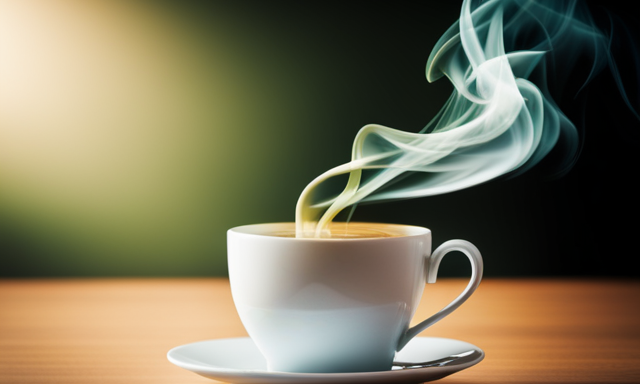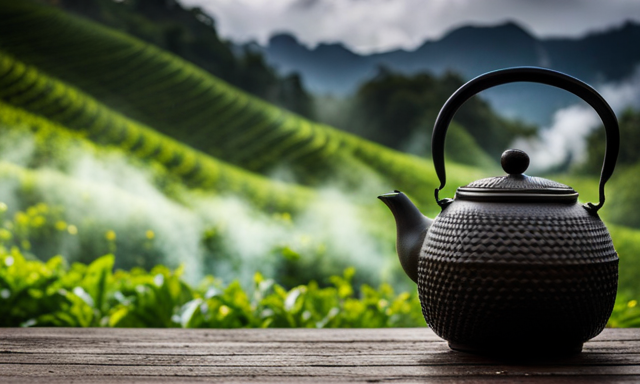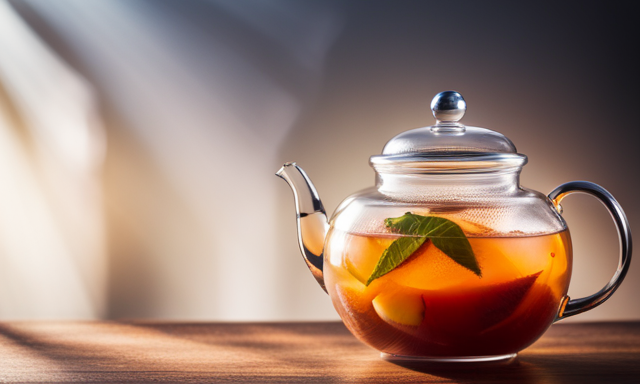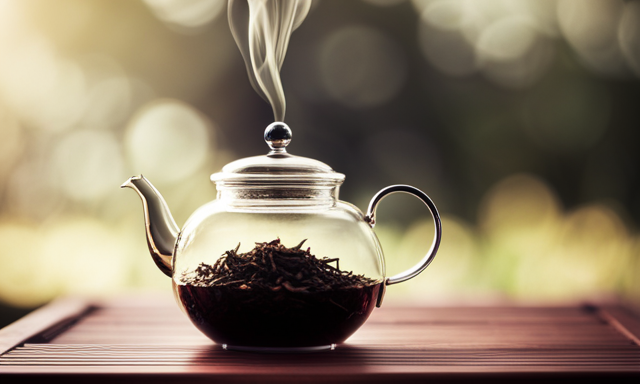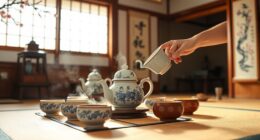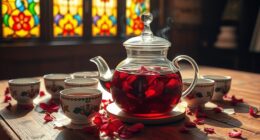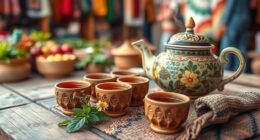Yes, it’s true that oolong tea is the most diverse category of tea, offering flavors that range from delicate and floral to rich and robust.
And today, I’m here to share with you the perfect pairings for this versatile and delicious beverage. Whether you’re a tea connoisseur or just starting to explore the world of tea, knowing what goes well with oolong tea can enhance your overall experience and delight your taste buds.
From light and floral pastries to spicy foods and nutty snacks, there’s something for everyone to enjoy.
And let’s not forget about the refreshing combination of oolong tea with fresh fruits or the harmonious blend of flavors when paired with cheese and charcuterie.
So sit back, relax, and get ready to discover the perfect companions for your next cup of oolong tea. Cheers!
Key Takeaways
- Nutty snacks such as almond butter cookies and cashew brittle pair well with oolong tea.
- Light salads like quinoa salad and cucumber salad provide a refreshing and balanced accompaniment to oolong tea.
- Seafood dishes like grilled shrimp skewers and steamed fish with ginger and soy sauce complement the flavors of oolong tea.
- Herbal infusions like chamomile tea, peppermint tea, and lavender tea can be enjoyed alongside oolong tea for their calming and aromatic properties.
Light and Floral Pastries
You’ll love how the light and floral pastries perfectly complement your oolong tea, creating a delightful harmony of flavors and aromas.
These flaky pastries and delicate cakes are the ideal accompaniments to your tea experience. The subtle, buttery layers of the flaky pastries provide a satisfying crunch that pairs exceptionally well with the smoothness of oolong tea.
Whether it’s a buttery croissant or a dainty macaron, these pastries add a touch of elegance to your tea time ritual. The delicate cakes, with their airy textures and gentle sweetness, enhance the floral notes of the oolong tea, creating a truly delightful combination.
As you savor each bite, the flavors of the pastries and the tea blend seamlessly, transporting you to a world of indulgence and tranquility.
Now, let’s move on to the next section where we explore the perfect pairing of oolong tea with fresh fruits.
Fresh Fruits
Indulge in the delightful combination of oolong tea and the vibrant sweetness of fresh fruits. The crisp and juicy nature of fresh fruits perfectly complements the smooth and fragrant flavor of oolong tea.
For a refreshing twist, try pairing your oolong tea with a refreshing fresh fruit smoothie. The combination of the tea’s earthy notes with the natural sweetness of fruits like berries, mango, or pineapple creates a harmonious blend of flavors.
If you prefer something lighter, a fruit salad is an excellent option. The juicy goodness of watermelon, the tanginess of citrus fruits, and the sweetness of ripe strawberries make for a delightful contrast to the tea’s complexity.
As we move on to the next section about ‘cheese and charcuterie,’ let’s explore how these savory bites can perfectly balance the flavors of oolong tea.
Cheese and Charcuterie
Get ready to embark on a flavor adventure with a tantalizing spread of cheese and charcuterie that perfectly complements your favorite cup of oolong tea.
The delicate and floral notes of oolong tea are beautifully enhanced by the rich and creamy flavors of cheese. Pairing a mild and creamy cheese like brie with oolong tea creates a harmonious balance of flavors. For a bolder taste, try a sharp cheddar or a tangy goat cheese to contrast with the tea’s subtle sweetness.
When it comes to charcuterie, the smoky and savory flavors of cured meats like prosciutto or salami make for an irresistible combination with oolong tea. The saltiness of the meat complements the tea’s earthy undertones, leaving your taste buds craving for more.
Now, let’s dive into the world of Asian cuisine and discover how oolong tea can elevate your dining experience.
Asian Cuisine
When it comes to Asian cuisine, there are a few key points that immediately come to mind.
First, I can’t resist the delicate and flavorful Dim Sum and Dumplings, which are bite-sized pieces of heaven.
Next, Sushi and Sashimi are a must-try for seafood lovers, with their fresh and expertly prepared fish.
And finally, Stir-fried Noodles or Rice are a staple in Asian cuisine, offering a satisfying and delicious combination of flavors and textures.
Dim Sum and Dumplings
Savor the exquisite harmony of oolong tea as it dances elegantly alongside an array of delicate dim sum and succulent dumplings, creating a symphony of flavors that will transport your taste buds to a culinary paradise. When indulging in dim sum, it is important to observe the traditional etiquette, such as using chopsticks and sharing plates with your dining companions. As you sip on your oolong tea, let its smooth and slightly fruity notes complement the steamed dumplings, savory buns, and flavorful rolls. Picture a table adorned with steaming bamboo baskets, filled with shrimp dumplings, pork siu mai, and fluffy char siu bao. The aroma fills the air, inviting you to taste each morsel. Some popular oolong tea brands to pair with dim sum include Tie Guan Yin, Da Hong Pao, and Dong Ding. As we move on to the next section on sushi and sashimi, prepare yourself for a journey into the world of raw fish delicacies.
Sushi and Sashimi
Imagine yourself sitting at a sushi bar, mesmerized by the masterful knife skills of the sushi chef. He expertly slices through the freshest cuts of fish, creating delicate pieces of sashimi that practically melt in your mouth.
Pairing sushi with oolong tea can elevate your dining experience to a new level. Here are three perfect accompaniments to savor alongside your sushi:
-
Ginger: The pickled ginger cleanses your palate between each bite, allowing you to fully appreciate the nuanced flavors of the sushi and the oolong tea.
-
Wasabi: The pungent heat of wasabi adds a spicy kick to your sushi, complementing the rich, earthy notes of the oolong tea.
-
Soy Sauce: The umami-rich soy sauce enhances the natural flavors of the sushi and brings out the subtle complexities of the oolong tea.
As you finish your last piece of sashimi, the savory flavors linger on your tongue, making you crave the next part of your culinary journey: stir-fried noodles or rice.
Stir-fried Noodles or Rice
Indulge in the delectable stir-fried noodles or rice, a symphony of flavors that will transport your taste buds to a culinary paradise. The combination of oolong tea and stir-fried noodles or rice is a match made in heaven. The bold and robust flavors of the tea perfectly complement the savory and aromatic qualities of the dish. Stir-fried noodles or rice are typically made by tossing noodles or rice in a hot wok with a medley of vegetables, meats, and sauces. The result is a harmonious blend of textures and tastes, with each bite bursting with umami goodness. To enhance the experience, I have prepared a table that showcases the different ingredients commonly used in stir-fried noodles or rice, along with their flavors and textures. Now, let’s move on to the next section and explore the tantalizing world of spicy foods.
Spicy Foods
Pairing oolong tea with spicy foods will ignite your taste buds and create a tantalizing explosion of flavors. The spicy flavor pairings complement the rich and complex taste of oolong tea, resulting in a harmonious blend of sensations. Here are three incredible combinations that will take your culinary experience to new heights:
-
Spicy Sichuan Mapo Tofu: The numbing heat of Sichuan peppercorns combined with the savory tofu creates a perfect balance with the floral and fruity notes of oolong tea.
-
Spicy Thai Green Curry: The vibrant flavors of lemongrass, chili, and galangal in this classic dish harmonize with the earthy undertones of oolong tea, enhancing each other’s spiciness.
-
Spicy Korean Kimchi Stew: The fiery and tangy flavors of kimchi meld perfectly with the robust and aromatic profile of oolong tea, creating an invigorating and satisfying combination.
Pairing oolong tea with spicy foods not only delights your taste buds but also offers numerous health benefits. Now, let’s move on to the next section and explore the wonderful world of oolong tea paired with chocolate.
Chocolate
Are you ready to discover the decadent and irresistible world of chocolate paired with the tantalizing flavors of oolong tea? This exquisite combination not only satisfies your taste buds but also offers numerous health benefits. When oolong tea’s floral and fruity notes intermingle with the rich and velvety taste of chocolate, it creates a harmonious symphony of flavors that is simply divine. The bitterness of dark chocolate complements the smoothness of oolong tea, while the sweetness of milk chocolate enhances its delicate nuances. To help you visualize the blissful experience, imagine a table set with a variety of chocolates ranging from silky truffles to crunchy chocolate-covered almonds, all elegantly arranged alongside a steaming pot of oolong tea. As you indulge, each bite of chocolate melts in your mouth, revealing its intricate flavors that perfectly match the aromatic complexities of oolong tea. Now, let’s explore the next tantalizing pairing: nutty snacks.
Nutty Snacks
Savor the irresistible crunch of nutty snacks as they perfectly complement the velvety smoothness of chocolate, creating a symphony of flavors that will leave you craving for more. Indulging in oolong tea with these delectable treats takes dessert pairings to a whole new level.
Here are five nut butter snacks that harmonize flawlessly with the rich taste of oolong tea:
-
Almond butter cookies: The nutty aroma of almonds combined with the buttery texture of these cookies creates a heavenly match.
-
Peanut butter pretzels: The salty pretzels dipped in creamy peanut butter provide a delightful contrast to the earthiness of oolong tea.
-
Cashew brittle: The sweet crunch of cashew brittle adds a delightful texture to the smoothness of oolong tea.
-
Hazelnut chocolate spread: Spread this decadent hazelnut chocolate on a slice of warm toast and enjoy the divine fusion of flavors.
-
Pistachio biscotti: The delicate pistachio flavor complements the floral notes of oolong tea, making it a delightful afternoon treat.
Transitioning into the next section about light salads, explore how these refreshing dishes perfectly balance the indulgence of nutty snacks.
Light Salads
After indulging in some nutty snacks with my oolong tea, it’s time to balance out the flavors with something lighter. Enter light salads, the perfect accompaniment to oolong tea.
One option is a refreshing quinoa salad, packed with protein and nutrients. The nutty flavor of the quinoa complements the earthy notes of the tea, creating a harmonious combination.
Another option is a cool and crisp cucumber salad. The crispness of the cucumber adds a refreshing element to the tea, while the mild flavor doesn’t overpower the delicate notes of the oolong.
Both salads provide a light and healthy contrast to the richness of the tea, allowing you to savor each sip without feeling overwhelmed.
Now, let’s dive into the next section and explore the wonderful world of seafood.
Seafood
When it comes to pairing seafood with oolong tea, I highly recommend trying three delectable options:
-
Grilled Shrimp Skewers: The succulent grilled shrimp skewers, with their smoky flavor and tender texture, complement the rich and earthy notes of oolong tea perfectly.
-
Steamed Fish with Ginger and Soy Sauce: The delicate and aromatic steamed fish, enhanced by the zing of ginger and the savory soy sauce, creates a harmonious balance with the smooth and floral oolong tea.
-
Lobster Rolls: Lastly, the indulgent and buttery lobster rolls, with their sweet and savory flavors, beautifully contrast with the robust and complex profile of oolong tea.
Grilled Shrimp Skewers
Deliciously grilled shrimp skewers are the perfect accompaniment to a warm cup of oolong tea, creating a harmonious blend of smoky flavors and aromatic sensations.
When it comes to grilled shrimp, the marinade plays a crucial role in enhancing the taste and tenderness of the shrimp. There are various grilled shrimp marinades to choose from, such as a zesty lemon and garlic marinade or a tangy teriyaki glaze.
To achieve perfectly grilled shrimp skewers, it is important to use proper grilling techniques. Preheating the grill, oiling the grates, and cooking the shrimp over medium-high heat for a few minutes on each side will result in succulent and flavorful shrimp.
Now, let’s move on to another delectable seafood option that pairs wonderfully with oolong tea: steamed fish with ginger and soy sauce.
Steamed Fish with Ginger and Soy Sauce
For a delightful culinary experience, why not try steaming fish with ginger and soy sauce? Steamed fish is not only a healthy choice, but it also allows the delicate flavors of the fish to shine through.
Ginger adds a subtle warmth and depth to the dish, while soy sauce brings a savory umami flavor. Here are a few reasons why steamed fish with ginger and soy sauce is a fantastic option:
- The gentle steaming method preserves the natural moisture and tenderness of the fish.
- Ginger and soy sauce create a harmonious balance of flavors that complement the fish beautifully.
- Steamed fish is a low-fat, high-protein dish that is incredibly nutritious.
- It is a versatile dish that can be prepared with various types of fish, such as salmon, cod, or snapper.
- Steaming fish helps retain its natural nutrients, making it a healthier choice compared to other cooking methods.
Now, let’s move on to the next delectable treat: lobster rolls.
Lobster Rolls
After exploring the delicious combination of steamed fish with ginger and soy sauce, let’s dive into another mouthwatering pairing for oolong tea: lobster rolls.
Lobster rolls are a classic seafood dish that perfectly complement the rich flavor profile of oolong tea. There are various lobster roll recipes and variations to suit every taste, from traditional New England-style rolls with buttered buns and a hint of mayo, to Asian-inspired rolls with a tangy soy-based dressing.
The succulent and tender lobster meat, nestled in a buttery, toasted bun, creates a delightful contrast to the aromatic and complex notes of oolong tea. The sweetness of the lobster and the refreshing qualities of the tea make for an exquisite culinary experience.
Now, let’s move on to our next topic: herbal infusions.
Herbal Infusions
When it comes to herbal infusions, there are a few key players that never disappoint.
First up is chamomile tea, known for its calming and soothing properties. Its delicate floral taste pairs perfectly with a cozy evening by the fire.
Next is peppermint tea, with its refreshing and invigorating flavor that can help with digestion and provide a burst of energy.
Lastly, lavender tea, with its calming and floral notes, is the perfect choice for relaxation and unwinding after a long day.
Chamomile Tea
If you’re looking for a soothing and calming beverage to complement your oolong tea, chamomile tea might just be your cup of tea.
Chamomile tea has numerous benefits that make it an ideal choice to pair with oolong. It is known for its relaxing properties and is often used to promote better sleep and reduce anxiety.
To brew chamomile tea, simply steep the dried flowers in hot water for about 5 minutes, then strain and enjoy.
The delicate floral aroma and subtle sweetness of chamomile tea perfectly balance the earthy and rich flavors of oolong tea. When sipping this delightful combination, you’ll experience a harmonious blend of flavors that will leave you feeling refreshed and rejuvenated.
Now, let’s move on to explore the invigorating qualities of peppermint tea.
Peppermint Tea
Peppermint tea is another wonderful option to pair with oolong tea. Its invigorating and refreshing flavor complements the richness of oolong perfectly. Not only does peppermint tea have a delicious taste, but it also offers numerous health benefits. From aiding digestion to soothing headaches, peppermint tea is a natural remedy for various ailments. It is known for its calming effect on the stomach and its ability to relieve bloating and indigestion. Additionally, peppermint tea is rich in antioxidants and can help boost the immune system. To illustrate the benefits of peppermint tea, consider the following table:
| Health Benefits of Peppermint Tea |
|---|
| Aids Digestion |
| Relieves Headaches |
| Boosts Immune System |
Now, let’s move on to the next subtopic: lavender tea.
Lavender Tea
Lavender tea is a delightful option that beautifully complements the richness of oolong tea with its soothing and aromatic flavor.
Not only does lavender tea taste wonderful, but it also offers many benefits for both the body and mind.
Lavender tea is known for its calming properties, making it the perfect companion to oolong tea, which is already known for its relaxing effects.
The combination of the two creates a truly serene and tranquil experience.
To make lavender tea, simply steep dried lavender buds in hot water for about 5-10 minutes.
You can also add a touch of honey or lemon to enhance the flavor.
So, if you’re looking for a delicious and calming beverage to enjoy alongside your oolong tea, lavender tea is the perfect choice.
Frequently Asked Questions
Can oolong tea be enjoyed with desserts other than pastries?
Oolong tea can definitely be enjoyed with desserts other than pastries. Some unique dessert pairings include indulging in a creamy scoop of ice cream or savoring the rich flavors of chocolate truffles alongside a cup of oolong tea.
Are there any fruits that pair particularly well with oolong tea?
Fruits like peaches, apples, and berries pair wonderfully with oolong tea. Not only do they complement its delicate flavor, but they also enhance the health benefits of oolong tea, such as improved digestion and boosted metabolism.
Is there a specific type of cheese that pairs best with oolong tea?
The best cheese pairings for oolong tea include creamy and nutty options like Gouda or Camembert. These cheeses complement the tea’s delicate flavors and create a delightful contrast. As for alternative dessert options, try pairing oolong tea with a light fruit tart or a rich dark chocolate mousse.
Which Asian cuisine dishes complement the flavor profile of oolong tea?
I love pairing oolong tea with traditional Chinese dishes like dim sum, stir-fried noodles, and Peking duck. The earthy and floral notes of oolong tea also complement the delicate flavors of Japanese cuisine, such as sushi and tempura.
Can oolong tea be a good option to balance the spiciness of certain foods?
Oolong tea is a refreshing palate cleanser that beautifully balances the spiciness of certain foods. Its versatility in savory culinary pairings makes it the go-to choice for those seeking a satisfying and harmonious dining experience.
Conclusion
In conclusion, oolong tea is a versatile beverage that pairs well with a variety of flavors. It goes well with light and floral pastries, such as scones or macarons. The delicate flavors of oolong tea complement the sweetness and buttery textures of these treats.
On the other hand, oolong tea also pairs nicely with spicy foods. The slightly smoky and earthy notes of the tea can help balance the heat and intensity of spicy dishes. Whether it’s a spicy curry or a fiery bowl of noodles, oolong tea can provide a refreshing and cooling effect.
Seafood dishes are another great match for oolong tea. The clean and crisp flavors of the tea can enhance the natural flavors of seafood, whether it’s grilled fish, shrimp, or even sushi. The subtle floral and fruity undertones of oolong tea can elevate the taste of seafood to a whole new level.
If you’re looking for a light and healthy snack to enjoy with oolong tea, try pairing it with nuts. The nutty flavors of almonds, cashews, or pistachios can complement the smooth and slightly nutty taste of oolong tea. It’s a satisfying combination that provides a good balance of flavors.
For those who prefer a non-caffeinated option, herbal infusions can be a great choice to enjoy with oolong tea. The herbal flavors can add an extra layer of complexity to the tea, creating a unique and enjoyable drinking experience. Whether it’s chamomile, mint, or lavender, experiment with different herbal infusions to find your perfect combination.
So why not indulge in a cup of oolong tea and discover the perfect combination for your next dining experience? Whether it’s a sweet pastry, a spicy dish, or a refreshing herbal infusion, oolong tea is sure to satisfy your taste buds and enhance your dining experience. Cheers to the wonderful world of oolong tea!



